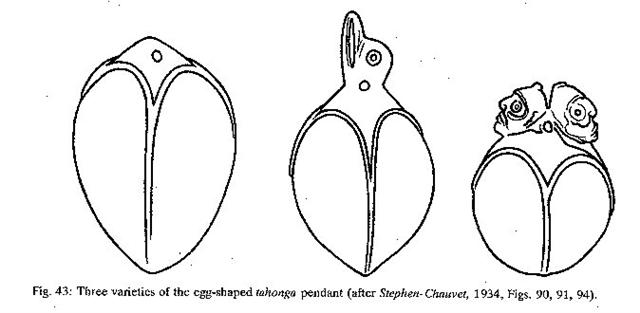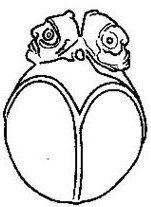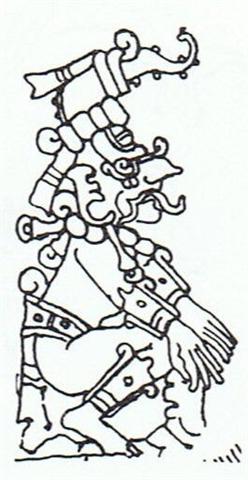4. Taho, the alternative to transcribe
kaho in Kaho-ali'i, can be changed into 'swallow' by
adding -ro:
|
Taho
Pau.: tahoko, reprisal,
revenge. Ta.: tahoo, recompense, revenge.
Tahoro, to swallow. Ta. tahoro,
id. Churchill |
There should be some connection between
'revenge' (tahoko) and 'to swallow' (tahoro) because
both words begin with taho. It is easy to
identify the link, viz. cannibalism. To eat your slain
enemy was the ultimate revenge. Possibly, it strikes me,
cannibalism as a custom could have evolved from eating
an eye in order to demonstrate how 2 'eyes' could be
changed into a single 'eye'.
By adding -ga we will reach tahoga:
|
Tahoga Figurine made of wood or of stone, in the shape of a
heart, which used to be worn on the chest. Vanaga.
Spherical pendant of wood worn around the neck.
Fischer.
Kaona,
a Hawaiian word that means 'veiled meaning or symbolism'. D'Alleva. |
| "Although stone specimens do occur, most
tahonga are carved from toromiro ... Great numbers
have been collected, some of considerable antiquity, although commercial
production was started in the late eighties of last century.
Basically, the form is that of a somewhat egg-shaped ball
with a central projection at its thickest end perforated for a
suspension string. The resemblance to an egg is reduced by the fact that
the tahonga is divided longitudinally into four equal sections by
four narrow ribbons or ridges radiating symmetrically from the most
pointed end of the ball.
At the rounded transition to the thicker end each
ribbon forks into two branches as wide as the original ones, and these
curve in both directions to run uninterruptedly into the meeting
branches from the two neighboring ribbons.
Seen from the rounder end of the ball, these
interlocked branches outline a star-shaped square with concave sides and
corners drawn out into points. Placed centrally in this modified square
is the small rounded or cylindrical projection perforated for the
suspension string. In some specimens this projection is shaped into
either a single or a double human head, and sometimes also into the head
of a bird with a large upturned bead. Obsidian disks with bone rings are
inlaid as eyes in these heads. The surfaces are polished and left
unpainted. Tahonga balls are commonly about 3-4 ins. (8-10 cm.)
along the axis, although they may vary somewhat in size.

Possible origins: The
tahonga was supposed to be a feminine ornament, although Métraux's (Ibid.,
p. 233) modern informants believed this was not universally so.
Specimens with a bird's head projecting from the top (Fig. 43 center)
suggest a cracking egg about to fall into four equal parts as the
chicken emerges. Some tahonga have a rather striking resemblance
to a coconut covered with its outer husk, although a husked coconut has
a rounded triangular cross section.
The theory that the pendant is an imitation of
coconuts which grew in the homeland of the ancestors has been both
defended and rejected (loc. cit.). In either case we would have
had no guide as to the origin of this purely local ornament, since
coconuts grew in a restricted grove on Easter Island itself prior to
missionary arrival (Heyerdahl, 1961, p. 30). As concluded by
Métraux (1940, p.236), the wooden tahonga seem to be
paraphernalia entirely peculiar to Easter Island.
Since some tahonga have a twin human head
emerging from the top (Fig. 43 right) it is interesting to recall the
belief prevailing in some parts of the Inca Empire, that the first Inca
and his sister-wife originally emerged from an egg. The association
seems pertinent when we note that Hotu Matua, the traditional
founder of the Easter Island dynasty, who was recalled to have come from
the direction of Peru, was remembered as the son of a king named
Tupa-ringa-anga (Métraux, 1940, p. 127).
Anga means to
'create' on Easter Island, and Tupa-ringa strongly suggests
Tupa-inga, a name frequently given to Inca Tupac, the late Inca who
sailed with a fleet into the Pacific to visit islands known to his
coastal merchants. This late Tupa-inga had only taken his name
from several of his own predecessors, since there were no less than 20
kings with this name in the Peruvian genealogical lines, most of them
going back into pre-Inca dynasties (Monesinos, 1642)." (Thor
Heyerdahl, The Art of Easter Island. |
The
specimen at right has 2 eyes because there are 2 heads
in Janus position, and the head at
left ends with a little 'bud':

The noted resemblance with a coconut is presumably relevant, because
there was a ceremony of breaking a coconut at new year on Hawaii, timed to
coincide with the reemergence of the Pleiades.
"... In the Ilocos
region of northern Philippines, the Ilocano people fill two halved
coconut shells with diket (cooked sweet rice), and place liningta nga
itlog (halved boiled eggs) on top of it. This ritual is known as niniyogan
and is an offering made to the deceased and one's past ancestors. This
accompanies the palagip (prayer to the dead).
A coconut (Sanskrit:
narikela) is an essential element of
rituals in Hindu tradition. Often it is decorated with bright metal foils and
other symbols of auspiciousness. It is offered during worship to a Hindu god or
goddess. Irrespective of their religious affiliation, fishermen of India often
offer it to the rivers and seas in the hopes of having bountiful catches. Hindus
often initiate the beginning of any new activity by breaking a coconut to ensure
the blessings of the gods and successful completion of the activity.
The Hindu goddess of
well-being and wealth, Lakshmi, is often shown holding a coconut. In the
foothills of the temple town of Palani, before going to worship
Murugan for the Ganesha, coconuts are broken at a place marked for
the purpose. Every day, thousands of coconuts are broken, and some devotees
break even 108 coconuts at a time as per the prayer. In tantric practices,
coconuts are sometimes used as substitutes for human skulls. In Hindu wedding
ceremonies, a coconut is placed over the opening of a pot, representing a womb
..." (Wikipedia) Through one
of the 'eyes' of the old nut ('coco') a new life will emerge:

Maybe this remarkable event was the basic one, later used to picture what
happens with the old 'eye' (year) at winter solstice. The young new plant
is evidently cannibalizing upon the old 'calabash'. At a new year 'death is near'
(for the old one), koke-na-make. Maybe
day number 366 is illustrated with a nut at bottom right and maybe the
forward-looking tagata personifies the new
sprout:
 |
|
Gb5-12 (366) |
Looking forward and up is a
characteristic of a young one:

|




